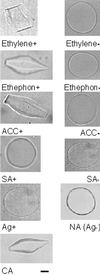Ethylene induces antifreeze activity in winter rye leaves
- PMID: 11457973
- PMCID: PMC116479
- DOI: 10.1104/pp.126.3.1232
Ethylene induces antifreeze activity in winter rye leaves
Abstract
Antifreeze activity is induced by cold temperatures in winter rye (Secale cereale) leaves. The activity arises from six antifreeze proteins that accumulate in the apoplast of winter rye leaves during cold acclimation. The individual antifreeze proteins are similar to pathogenesis-related proteins, including glucanases, chitinases, and thaumatin-like proteins. The objective of this study was to study the regulation of antifreeze activity in response to ethylene and salicyclic acid, which are known regulators of pathogenesis-related proteins induced by pathogens. Nonacclimated plants treated with salicylic acid accumulated apoplastic proteins with no antifreeze activity. In contrast, when nonacclimated plants were exposed to ethylene, both antifreeze activity and the concentration of apoplastic protein increased in rye leaves. Immunoblotting revealed that six of the seven accumulated apoplastic proteins consisted of two glucanases, two chitinases, and two thaumatin-like proteins. The ethylene-releasing agent ethephon and the ethylene precursor 1-aminocyclopropane-1-carboxylate also induced high levels of antifreeze activity at 20 degrees C, and this effect could be blocked by the ethylene inhibitor AgNO(3). When intact rye plants were exposed to 5 degrees C, endogenous ethylene production and antifreeze activity were detected within 12 and 48 h of exposure to cold, respectively. Rye plants exposed to drought produced both ethylene and antifreeze activity within 24 h. We conclude that ethylene is involved in regulating antifreeze activity in winter rye in response to cold and drought.
Figures





Similar articles
-
Winter rye antifreeze activity increases in response to cold and drought, but not abscisic acid.Physiol Plant. 2001 May;112(1):78-86. doi: 10.1034/j.1399-3054.2001.1120111.x. Physiol Plant. 2001. PMID: 11319018
-
Immunolocalization of Antifreeze Proteins in Winter Rye Leaves, Crowns, and Roots by Tissue Printing.Plant Physiol. 1996 Mar;110(3):845-857. doi: 10.1104/pp.110.3.845. Plant Physiol. 1996. PMID: 12226223 Free PMC article.
-
Chitinase genes responsive to cold encode antifreeze proteins in winter cereals.Plant Physiol. 2000 Nov;124(3):1251-64. doi: 10.1104/pp.124.3.1251. Plant Physiol. 2000. PMID: 11080301 Free PMC article.
-
Antifreeze proteins in overwintering plants: a tale of two activities.Trends Plant Sci. 2004 Aug;9(8):399-405. doi: 10.1016/j.tplants.2004.06.007. Trends Plant Sci. 2004. PMID: 15358271 Review.
-
Mechanism of Stomatal Closure in Plants Exposed to Drought and Cold Stress.Adv Exp Med Biol. 2018;1081:215-232. doi: 10.1007/978-981-13-1244-1_12. Adv Exp Med Biol. 2018. PMID: 30288712 Review.
Cited by
-
Ethylene signaling negatively regulates freezing tolerance by repressing expression of CBF and type-A ARR genes in Arabidopsis.Plant Cell. 2012 Jun;24(6):2578-95. doi: 10.1105/tpc.112.098640. Epub 2012 Jun 15. Plant Cell. 2012. PMID: 22706288 Free PMC article.
-
Genetic Mechanisms of Cold Signaling in Wheat (Triticum aestivum L.).Life (Basel). 2022 May 7;12(5):700. doi: 10.3390/life12050700. Life (Basel). 2022. PMID: 35629367 Free PMC article. Review.
-
CINV1 and CINV2 are required for increased tolerance to diverse stresses after ethylene-pretreatment of germinating seeds.PLoS One. 2025 Jul 15;20(7):e0328236. doi: 10.1371/journal.pone.0328236. eCollection 2025. PLoS One. 2025. PMID: 40663562 Free PMC article.
-
The Effect of Ethephon on Ethylene and Chlorophyll in Zoysia japonica Leaves.Int J Mol Sci. 2024 Jan 29;25(3):1663. doi: 10.3390/ijms25031663. Int J Mol Sci. 2024. PMID: 38338942 Free PMC article.
-
Brachypodium Antifreeze Protein Gene Products Inhibit Ice Recrystallisation, Attenuate Ice Nucleation, and Reduce Immune Response.Plants (Basel). 2022 May 31;11(11):1475. doi: 10.3390/plants11111475. Plants (Basel). 2022. PMID: 35684248 Free PMC article.
References
-
- Abeles FB. Ethylene in Plant Biology. New York: Academic Press; 1973.
-
- Boller T, Gehri A, Mauch F, Voegeli U. Chitinase in bean leaves: induction by ethylene, purification, properties, and possible function. Planta. 1983;157:22–31. - PubMed
-
- Bradford MM. A rapid and sensitive method for the quantification of microgram quantities of protein utilizing the principle of protein-dye binding. Anal Biochem. 1976;72:341–347. - PubMed
-
- Brederode FT, Linthorst HJM, Bol JF. Differential induction of acquired resistance and PR gene expression in tobacco by virus infection, ethephon treatment, UV light and wounding. Plant Mol Biol. 1991;17:1117–1125. - PubMed
Publication types
MeSH terms
Substances
LinkOut - more resources
Full Text Sources

